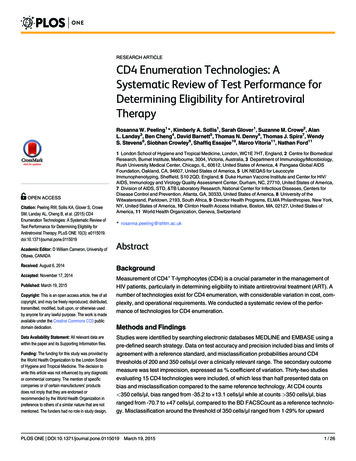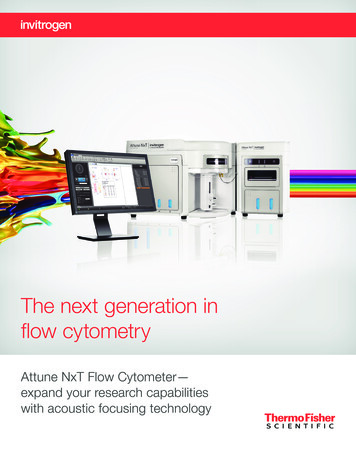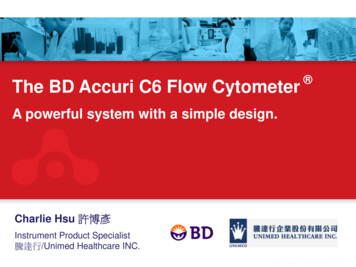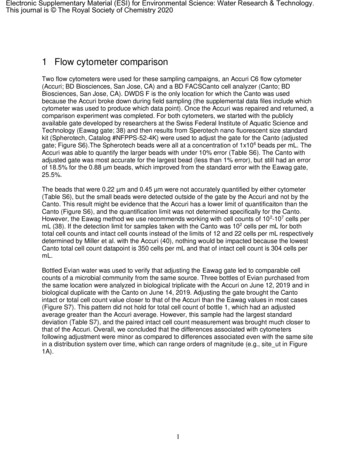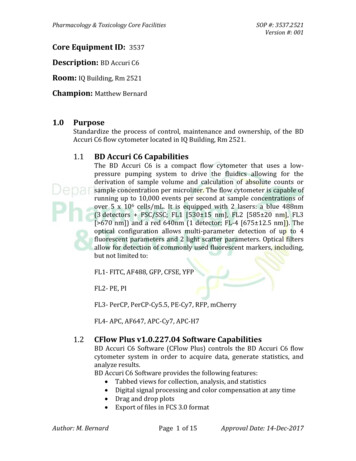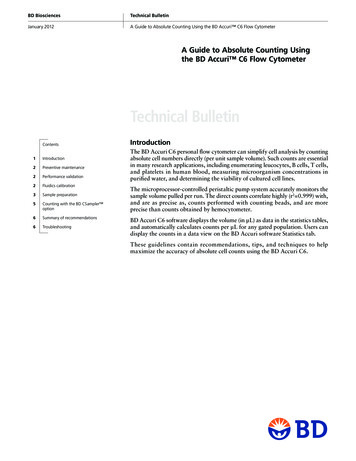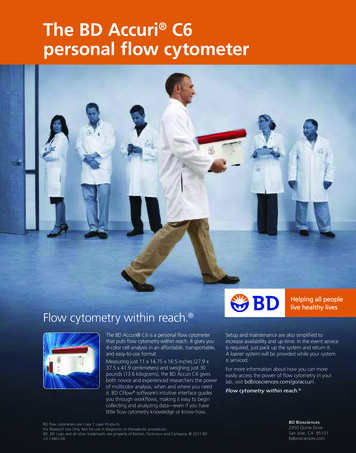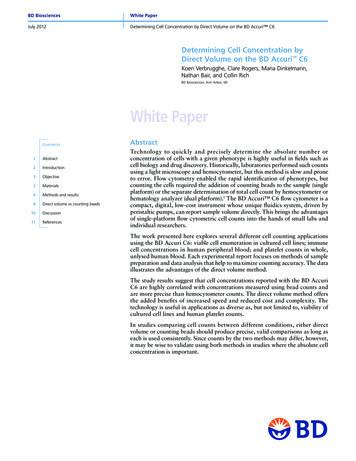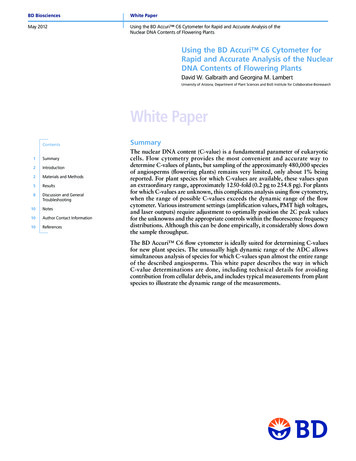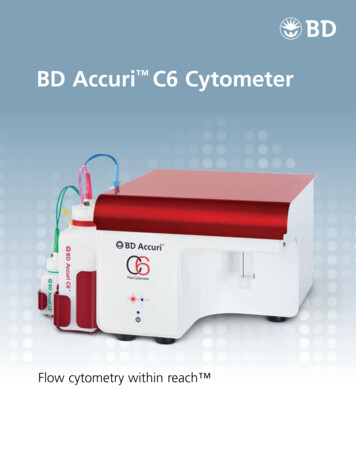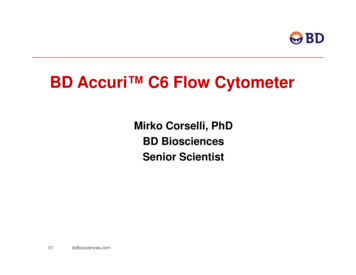
Transcription
BD Accuri C6 Flow CytometerMirko Corselli, PhDBD BiosciencesSenior Scientist01bdbiosciences.com
The BD Accuri C6 Flow Cytometer System An affordable, full-featured, easy-to-use flow cytometer Two lasers and six detectorsFlow Cytometry within Reach 02bdbiosciences.comThe BD Accuri C6 Personal Flow Cytometry Tour
BD Accuri C6 Flow CytometerDetectorsStatistical AnalysisSSCFSCLaser533 nm585 nmOutput670 nm675 nmSampleFlow Cytometry within Reach 03bdbiosciences.comThe BD Accuri C6 Personal Flow Cytometry Tour
Advantages of Pre-optimized DetectorSettings Greatly reduces the risk of lost data due to improper setup Saves time and sample No specialist training or dedicated operator required Predictable, reproducible analysis relative to the sample typeand applicationFlow Cytometry within Reach 04bdbiosciences.comThe BD Accuri C6 Personal Flow Cytometry Tour
Enhanced Sample Handling Direct volume measurement Many types of sample tubesmay be used.– Flow cytometry tubes– Microcentrifuge tubes– Ninety-six-well plates with theBD CSampler accessory Open system conduciveto kinetic studies BD CSampler accessory forautomated sample introductionFlow Cytometry within Reach 05bdbiosciences.comThe BD Accuri C6 Personal Flow Cytometry Tour
Intuitive SoftwareSample GridHistogram,Dot Plot,and DensityPlot DisplayAreaCytometerStatusAnalysisand GatingToolsFluidicsControlsRun CriteriaPlotStatisticsReal-TimeUpdatesFlow Cytometry within Reach 06bdbiosciences.comThe BD Accuri C6 Personal Flow Cytometry Tour
A Versatile Instrument for BroadApplicationsMicrobiology Aquatic microbiome analysis Biofuel research Bacteria viability and concentrationCell BiologyPlant Biology Apoptosis Proliferation Immunophenotyping DNA contentFluorescent Protein Analysis GFP,YFP mCherry , RFP mOrange , dTomato Flow Cytometry within Reach 07bdbiosciences.comThe BD Accuri C6 Personal Flow Cytometry Tour
Apoptosis: Annexin VDMSOLive cells:Annexin V NegativePI NegativeEarly apoptotic:Annexin V PositivePI NegativeCamptothecin6 µMLate apoptosis/dead:Annexin V PositivePI PositiveJurkat cells were treated with DMSO or camptothecin for 4 hours.Flow Cytometry within Reach 08bdbiosciences.comThe BD Accuri C6 Personal Flow Cytometry Tour
Analysis of Aquatic Samples fromSaginaw Bay: FluorescenceChlorophyll a,bP6: CyanobacteriaP7: Other phytoplanktonPhycoerythrinP8: PE fluorescentP9: Non-PE fluorescentFour types of phytoplankton were identified by fluorescence characteristics.Data courtesy of J.D. Bressie, PhD, NOAA, Seattle, WAFlow Cytometry within Reach 9bdbiosciences.comThe BD Accuri C6 Personal Flow Cytometry Tour
Kits and Templates on the BD AccuriC6010bdbiosciences.comFlow Cytometry within Reach The BD Accuri C6 Personal Flow Cytometry Tour
BD Accuri C6 Promotion and PersonalFlow Cytometry TourNote:US Region OnlyPromotion Period: Oct 1, 2014 – Dec 31, 2014The BD Accuri C6 Personal Flow Cytometry Tour Introduction to Flow Cytometry Cancer and Cell Biology Applications Microbial AnalysisFlow Cytometry within Reach The BD Accuri C6 Personal Flow Cytometry Tour
For Additional Information www.bdbiosciences.com/resources/accuriTechnical Support:Ph: 877-232-8995, Prompt 3, 2email: ResearchApplications@bd.comClass 1 Laser Product.For Research Use Only. Not for use in diagnostic or therapeutic procedures.Living Colors (including mCherry, mOrange, and dTomato dyes) is a registered trademark of Clontech.BD, BD Logo and all other trademarks are property of Becton, Dickinson and Company. 2014 BD23-16980-00
Flow cytometry inundergraduate educationWhitney EdwardsSamantha Scott, Talbot Weston, Sarah Murphy,Melanie Gubbels Bupp – Autumn ImmunologyConference 2014Melanie Gubbels Bupp, AssistantProfessor of Biology
General Advice on usingcytometry in highereducation Use the technology for projects that allow studentsto o more firmly grasp basic conceptso test something of interest to them Only tell them what they need to know about thetechnology WHEN they need to know it.o Front-loading a lot of technical information is overwhelming and often,ineffective
Examples of using cytometry atR‐MC Peritonitis Lab in Immunology course forbiology majors [simplified version taught in afreshman mixed (majors/non-majors) lab] Phagocytosis Lab in Immunology course forbiology majors Independent research projects forundergraduate students
Introduce students to the labThioglycollate‐Induced Peritonitis: Recruitment of leukocytesfrom the circulation, and their subsequent influx into the sites ofinflammation is critical for host defense and wound healing. Thisis a multistep process, which is regulated, in part, by adhesionmolecules and chemokines that are upregulated duringinflammation. An intra‐peritoneal injection of thioglycollategenerates local inflammation and initiates the migration ofinflammatory cells to the site of inflammation. Thus,thioglycollate‐induced peritonitis in mice mimics an acuteinflammatory response in the peritoneum.PeritoneumLearning Objectives Be able to identify particular white blood cells(lymphocytes, monocytes, neutrophils) in a bloodsmear. Explain how and why blood differentials are taken Describe the chronological order in which immunecells arrive at sites of inflammation, such as theperitoneal cavity in thioglycollate-treated mice.
Peritonitis Lab TimelineInject mice with TG (1hr timepoint); BloodLearn how to perform differentials on all TGsamples; count & stainand read bloodperitoneal cells fromdifferentialscontrol and TG mice(untreated mice)1Finish blooddifferential analysis;acquire cells on BDAccuri C6; dataanalysisGrouppresentations onlab discussionquestions342Weekly Lab SessionInject mice with 6% thioglycollate(TG) in PBS or control PBS toinduce peritoneal inflammation
R‐MC Immunology studentsacquiring their samplesVictoria RobinsonLauren Philips, Jane Oh, &Casey Kaufman
Explaining how cytometryworksCD8 Labeledantibodyspecific to CD4Labeledantibodyspecific to CD8CD8 Each dotis a cellThymus2.8DP81.73.9CD8DNDPDNCD4Flow CytometerCD8CD4 CD4CD4 11.6
Example student dataCD3‐APC2.3%CD3‐APCCD19‐PerCP1.2%1 hour post‐TG1 day post‐TG0.3%1.6%CD3‐APC0.1%8.1%CD3‐APC2 days post‐TGCD19‐PerCPT cellsCD19‐PerCPB cellsCD19‐PerCPCD19‐PerCPPBS Control3.3%1.7%CD3‐APC
Example student dataPBS Control1 hour 1%Ly6G/C‐FITCCD11b‐PE1 day 1.1%Ly6G/C‐FITC
Example discussion questionsfor student peritonitispresentations What types of junctions exist between endothelial cells liningblood vessel walls in the non-inflamed, resting condition? Howdo these junctions change during local inflammation?Relate your findings from the blood differentials with yourfindings from the flow cytometry data. Do the two sets ofdata “paint the same picture”? Why or why not?Map the route newly developed neutrophils must take toenter the inflamed peritoneal cavity. Begin in the bonemarrow and end with the peritoneal cavity.
Examples of using cytometry atR‐MC Peritonitis Lab in Immunology course forbiology majors [simplified version taught in afreshman mixed (majors/non-majors) lab] Phagocytosis Lab in Immunology course forbiology majors Independent research projects forundergraduate students
Introduce students to the labBloodMonocytesLearning Objectives Compare and contrastmonocytes and macrophages Evaluate flow cytometry dataregarding the ability of cells tophagocytose fluorescentlytagged antigens Be able to design anexperiment to test the impact ofvarious compounds onphagocytosisTissueMacrophages
Phagocytosis Lab TimelineLearn how to cultureTHP‐1 cells; designexperiment to testeffect of particularsubstance onphagocytosis (in vitro)1Incubate THP‐1 cellswith FITC‐latexbeads, and acquiresamples on BD AccuriC6; data analysisGrouppresentations onlab discussionquestions2Weekly Lab Session3Set up THP‐1 cultures in 24 wellplates /‐ PMA and /‐ test substanceTHP-1monocytes PMA24 hTHP-1macrophages
Explaining how cytometryworks ‐‐ histogramsCountLots of phagocytosisVery little phagocytosisFlow CytometerCountFITC ‐ beadsFITC‐beads
Example student dataTHP cells0%THP cells FITC‐beadsTHP cells FITC‐beads Vitamin C45.3%52.3%76.1%66.5%0 PMAFITC‐beads PMACount0%FITC‐beads
Examples of using cytometry atR‐MC Peritonitis Lab in Immunology course forbiology majors [simplified version taught in afreshman mixed (majors/non-majors) lab] Phagocytosis Lab in Immunology course forbiology majors Independent research projects forundergraduate students
Students at R‐MC also use thecytometer in independentresearch projects7AADApoptosis MarkersAnnexin V - PESeth LitvinWhitney Edwards
Students at R‐MC also use thecytometer in independentresearch projectsCountSort them on CD127 expressionSarah MurphyIsolate Naïve CD8 Tcells from Donor miceCD127loCD127hiCD127Adoptively Transfercells into recipients CFSEhiCFSEloCD127loCD127hi2.5 x1062.5 x}106MALAL1 weekAssess totalnumbers andCD127expression ofCFSE cells byflowcytometry
Students at R‐MC also use thecytometer in independentresearch projectsNaïve CD8 CFSE T Cellsin recipient LNsCountCD8 - PE*CFSE**CD127 - APC
Thank you to R‐MC studentsparticipating in labs andindependent research Whitney EdwardsErica HorsemanRebecca DavisSeth LitvinVictoria RobinsonJosh AnoffBrittany MihalcoeAlex KopplemanSamantha ScottSarah MurphyTalbot WestonTalbot Weston, Sarah Murphy,and Samantha Scott
Integrating Microbial FlowCytometry Into EducationTim W OvertonBioengineering, School of Chemical EngineeringUniversity of Birminghamt.w.overton@bham.ac.uk @overtonlab
How can we get FCM applied inmicrobiology / microbial biotechnology? Collaboration between FCM specialists andmicrobiology / bioprocessing researchers Training at University levelUG / PGT taughtmaterialTheoryUG / PGT researchprojectsApplicationPhD level training &researchInnovation
Teaching fermentation MSc Biochemical Engineering– Fermentation and cell culture for production ofbiopharmaceuticals– Downstream processing of biopharmaceuticals– Systems and synthetic biology– Pharmaceutical, food and business themes– Research project
Teaching analysis of fermentation Theory sessions on analytical techniques– Online versus offline– Real time / non‐real time– Bulk versus single cell– Direct observations Theory and advantages of FCM
Lab‐scale fermentation Growth of E. coli in 5litre bioreactors Analysis:– Traditional techniques:pH, DOT, offgas– Biomass measurements: Optical density Colony forming units Dry cell weight– FCM
Fermentation l techniques:Dissolved O2 and pHBasics of growth andphysiology5.800246Time (hours)4Rate (AU) / RQ3.53O2 consumption,CO2 evolutionBasics of growth andphysiology2.521.510.5002Time (hours)46
FCM with physiology dyesInjured1 hourDeadLivePropidium Iodide (PI)Enters cells through holes in wallStains dead cells redDiBac4(3) (Bisoxanol; BOX)Only enters depolarised cellsStains depolarised cells greenAdvantages: Rapid method Allows monitoring of VBNC bacteria Allows counting of cells
FCM with physiology dyes1 hour2 hours3 hours4 hours5 hours6 hours
Pilot plant Growth of E. coli in 150litre vessels over thecourse of a week Fed‐batch with glucose– Glucose feeding rate iscritical to success Students encouraged todevelop their ownanalysis methods andstrategies – including FCM
90405.554.50412172227% output6pH5010606.5506405.530OXC / CDCOxygen consumption& CO2 evolution5204.510403212Time 06030890770Team 21007.580% OutputBase addition rate & pH80pHTeam 11001722Time (hours)2732
Team 1 – FCM physiology monitoringMore dead and injured cells –reflects poor glucose feed controlTeam 2 – FCM physiology monitoringMore healthy cells – goodglucose feed control
Food microbiology Use of flow cytometry as a method formonitoring bacteria during food processing Acid resistance and acid adaptation Differentiation between bacteria and foodmatrix
MSc / MEng Research projects Monitoring physiology using dyes duringbiotransformation reactions Monitoring poly(3‐hydroxybutyrate) (PHB)productivity by bacterial cultures Recombinant protein‐GFP fusion studies toscreen new growth conditions such as choiceof carbon source– RP‐GFP fusions allow measurement of bothquantity and folding quality
GlucoseFructoseGlycerol
Doctoral training BBSRC‐funded MIBTP (Midlands IntegrativeBiosciences Training Partnership)– Warwick, Birmingham & Leicester Universities– 52 PhD students per year Extensive training programme:– Quantitative skills– Placements– Techniques masterclasses
Doctoral training ‐ master class Day 1:– Day of lecture / seminar teaching– Ability to go into detail and give examples– Papers given to students Day 2: Reading / preparation Day 3:– Students give 10 minute talks on papers– Practical session
Doctoral training ‐ practicalE. coli wild‐typeE. coli GFP S. cerevisiaeComparison of scatter measurementsLive & Dead cells with a variety of stains (PI, BOX,SYTO9) Unknown mixtures (problem‐solving aspect) Hands‐on time is invaluable to apply theory (andtest theory)
Challenges and opportunities Students have diverse backgrounds– Gaps in knowledge (e.g. optics, fluorescence)– Students can teach each other Students are interested in different areas– Comparisons with other techniques– Fertile ground for new ideas about methods andmeasurement techniques Students are very keen!
Outlook Training in theory of FCM is interdisciplinaryand needs life science and physical scienceknowledge. Comparison with previously‐used techniquesis helpful. Combination of taught material with practicalexperience is very useful.
AcknowledgementsPostdocs: Dr Isaac Vizcaino‐Caston & Dr Alfred Fernandez‐CastanePhD students: James Leech, Ikhlaas Kasli, Asma Zulkifly, Hani ElKadri, Hussam Fallatah; Duangkanok Tanangteerapong, ChrisWyre, Amir Anvarian, Louise HackettMSc / MEng students: Alifiana Sara, Adna Farah, David Walsh &Christian Mather, Matthew Bridgeman, Mauricio Santos, HeNa, Tianqi Wang, Adriana Benarroch, Raúl Mateos González,Ana Álvarez Martín, Shakthiswar Ragu, Kenneth Liu Hung Yaw,Samuel Harvey & David Rothera
Flow Cytometry within Reach The BD Accuri C6 Personal Flow Cytometry Tour Note: US Region Only Promotion Period: Oct 1, 2014 - Dec 31, 2014 BD Accuri C6 Promotion and Personal Flow Cytometry Tour The BD Accuri C6 Personal Flow Cytometry Tour Introduction to Flow Cytometry Cancer and Cell Biology Applications Microbial Analysis
